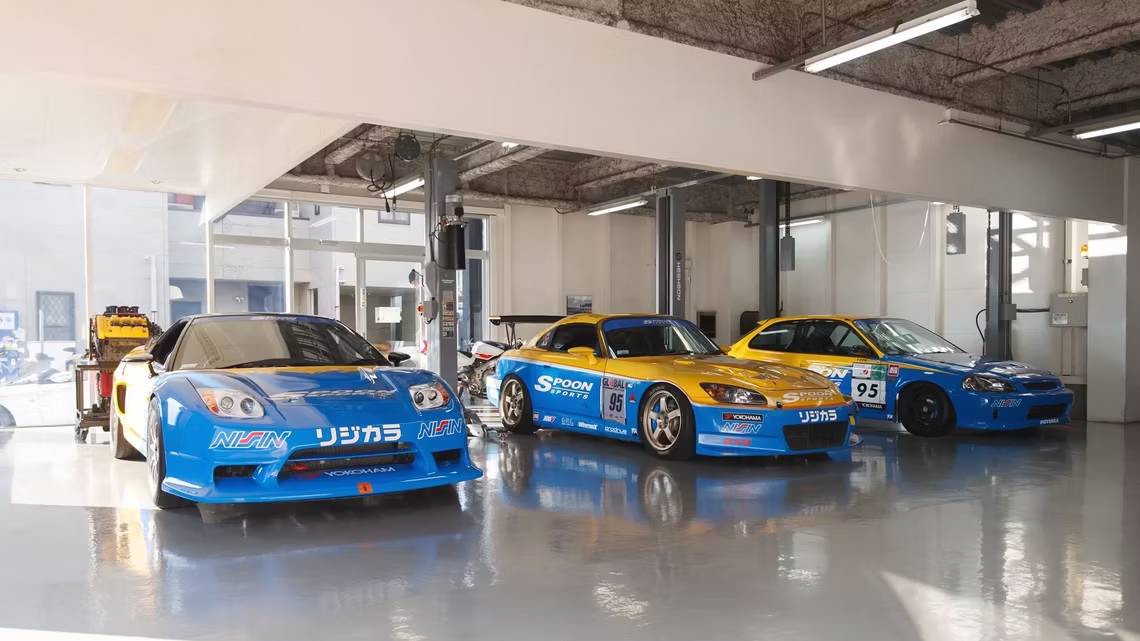Japan, renowned for its leading automobile manufacturing companies, also boasts some of the world’s best tuning companies. Among these, Spoon Sports stands out with its iconic blue and yellow liveries and its remarkable success in crafting rapid Honda track cars. In this article, we delve into the history and evolution of Spoon Sports, a legendary Japanese tuning company, as presented by James from Donut Media.
Spoon’s Humble Beginnings
Established in 1988, Spoon Sports Co., Ltd. started as an engine tuner and parts manufacturer, with a strong inclination towards vehicles produced by Honda Motor Company. Contrary to expectations, Spoon’s focus wasn’t solely on developing race cars; they aimed to create vehicles that offered both comfort and cutting-edge technology. Spoon developed a unique and robust relationship with Honda, becoming the preferred tuning partner for the factory.
Motorsport Ventures
Spoon Sports has left an indelible mark on various motorsport events, participating in the Tsukuba 9 Hours Endurance Race, Super Taiku, 24 Hours Nürburgring, 25 Hours of Thunderhill, U.S. Touring Car Championship (USTCC), and the VLN Championship in Germany. James explains that the founder, Tatsuru Ichishima, was an ordinary worker with a dream of building top-tier race cars. This dream began to materialize when he started working on a third-generation Honda Civic hatchback at the age of 33.
Turning a Honda Civic into a Racing Beast
Tatsuru’s choice of the Honda Civic, a small economy car in the 1980s, may have seemed unconventional to some. However, Honda’s design philosophy of balance and driving enjoyment made it an ideal foundation for a race car. The Civic underwent significant modifications, including stripping the interior for weight reduction, fitting Showa suspension components and Nissin brakes, and tuning the 1.6-liter ZC engine to produce an impressive 230 HP, a significant boost from the stock engine.
The iconic blue and yellow Spoon livery made its debut on this Civic, which was tuned to compete in Group A of the Japanese Touring Car Championship. Honda, without an official entry, collaborated with Spoon to gather valuable race data for mutual improvement. Little did Tatsuru know that his project would inspire a new generation of Honda enthusiasts.
Official Partnership with Honda
James details how Tatsuru’s success led to an official partnership with Honda in 1989. This partnership enabled Spoon to experiment with the Honda ECU, laying the foundation for thorough ECU tuning as a cornerstone of Spoon’s methodology. The unique relationship between Tatsuru and Honda with Nissin came to life, propelling Spoon Sports into the Japanese Grand Touring Car Series, now known as the Super GT.
Super GT and Honda EK9
With Super GT imposing restrictions on engine capacity, Spoon turned to the Honda NSX. This collaboration achieved a remarkable third-place finish at the challenging Macau street course, leading to Spoon-built Hondas competing globally at prestigious tracks like the Nürburgring and Tsukuba Circuit. In 1997, the Honda EK9, also known as the Type-R, was unveiled, following Spoon’s philosophy of creating stiffer and lighter versions of track-focused Hondas.
Pushing the Limits with Honda S2000
As James narrates, Spoon didn’t stop at the Civic Type-R; they continued to push the limits. The release of the Honda S2000 in the late 1990s provided Spoon with another canvas to showcase their expertise. Spoon’s treatment transformed the two-seater sports car into a formidable contender in endurance races, such as the prestigious 24 Hours of Le Mans.
Expansion and the Birth of Speed Shop Type One:
In 2001, Spoon Sports expanded its facilities, establishing Speed Shop Type One, a full workshop dedicated to proper installation and calibration. Tatsuru envisioned a space focused on creating completely tuned cars, emphasizing the harmony of components to deliver an optimal driving experience. James highlights Spoon’s return to Macau in 2007, where they had to build a new NSX since the last one was produced in 2005.
Restomodding Honda NSXs
With the scarcity of new NSXs, Spoon announced the restomodding of existing Honda/Acura NSXs. This decision allowed enthusiasts to experience the thrill of driving a Spoon-tuned NSX, replicating the Super GT cars. The restomodding included optional turbochargers, ECU tuning, suspension upgrades, brakes, and carbon-fiber bodywork. Spoon’s commitment to sharing its racing components with the public opened doors for enthusiasts to build their own Spoon Honda.
In the world of Japanese tuning companies, Spoon Sports stands as a testament to passion, innovation, and a relentless pursuit of excellence. From its humble beginnings tuning a Honda Civic to competing in prestigious motorsport events worldwide, Spoon Sports has solidified its place as a legendary JDM tuning company. Tatsuru Ichishima’s vision and dedication, as explained by James from Donut Media, provide insights into the journey that transformed Spoon Sports into a revered name among car enthusiasts worldwide.
READ MORE: The Last Of Us Part II Actor Says Fans Threatened Her Son

